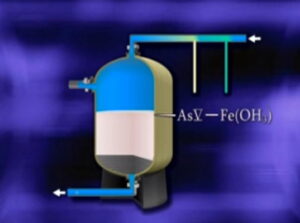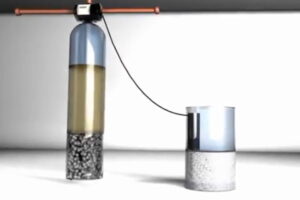What is Arsenic?
National Institute of Environmental Health Sciences (NIEHS) states that arsenic is a naturally occurring element that is found in the earth’s crust. It occurs in air, land, and soil. Arsenic exists in organic and inorganic forms.
Arsenic Symptoms in Well Water
Arsenic will not impart any color, taste, or smell to your drinking water. Hence, you cannot guess its presence. The only and best way to know about arsenic in your water is a water test. EPA and almost all the states recommend that a test for arsenic must be performed when a well is built, deepened, modified, or relocated.
You can test for arsenic using home testing kits or get your water tested from a certified laboratory.
Maximum Contamination Standards (MCL) for Arsenic in Water
The EPA reduced the MCL for arsenic from 50 parts per billion (ppb) to 10 ppb in 2001. It is equivalent to 10 micrograms per liter (µg/L).
Read more: Methods to Raise PH in Well Water
6 Ways to Treat Arsenic in Well Water
Minnesota Department of Health recommends the following water treatment options to remove arsenic from well water.
Reverse Osmosis – RO filter is the best pick to remove arsenic from drinking water. RO filters are usually installed under the sink but kitchen top models are also available. An RO filter has 4-5 different filtration stages including sediment, carbon and RO. The heart of the system is the RO membrane which can be as small as 0.0001 microns. RO filters are 99% effective in removing arsenic and other contaminants in water.
Suggested RO Filter to Remove Arsenic: SpringWell’s RO Filter
It is one of the best RO systems to remove arsenic, TDS, VOCs, heavy metals, bacteria, and up to 99% of contaminants found in water. SpringWell’s RO filter can filter 75 gallons of water daily and has a pressurized storage tank to store water.
One drawback of using RO filters is water wastage. These units waste 2-3 gallons of water for every gallon of filtered water.

Adsorptive Media Filters – The common types of adsorptive media used for arsenic removal are activated alumina and iron oxide. They can be installed as a point of entry (whole house) or point of use.
Adsorptive media filters are 95% effective in removing arsenic from well water. The success rate depends on water quality and arsenic concentration.
Adsorptive media filters may need a pre-sediment filter to ensure proper working. Just like an RO filter, adsorptive media filters also need backwashing and filtration media replacement. POE adsorptive media filters are costly and may cost you up to $2000 compared to point of use systems. You can install POI system for potable water.

Ion Exchange – Ion exchange technology can also be used to remove arsenic from your well water. Arsenic removal is achieved by continuously passing water under pressure at high speed through the water softener. Negative arsenic is captured by the sodium or potassium ions in the softener salt.
The resin is then washed by regular backwashing. The water produced from a water softener is soft and is rich in sodium or potassium. If you are planning to use a water softener for arsenic removal, make proper arrangements for drainage. People on a low sodium diet must not drink water from a water softener.
Distillation – Arsenic’s boiling point is higher than water. When water is distilled, the steam rising from the boiling container is cooled and turned back into the water. Arsenic stays in the boiling pot, and the resulting water is arsenic-free. Distillation is a complex process, and setting it up at your home will need a lot of investment, time, and energy. It is often used industrially to get pure water.
Ozone and Filtration – Ozone (O3) is also used to remove arsenic from water with the help of an electric injector. Ozone crystalizes arsenic and other impurities which are then removed using a sediment filter.
Oxidation Filters – Oxidation filters can also be used to remove arsenic from water. Arsenic is oxidized and is then removed using a filter.
How does Arsenic get into Well Water?
- Contamination through underground sources
- Run-off contamination from lakes, rivers, and floods
- Industrial waste
- Frequent use of arsenic-rich fertilizers near your well
What are the Health Affects of Drinking Arsenic Contaminated Water?
A study by NIEHS states that arsenic affects the following organs and systems in the human body.
- Skin
- Nervous system
- Respiratory system
- Cardiovascular system
- Liver, kidney, bladder, and prostate
- Immune system
- Endocrine system
- Development system
- Diabetes
- Lungs and liver cancer
- Respiratory diseases
- Slow brain development in children
Short term exposure to high levels of arsenic in drinking water can lead to stomach pain, nausea, vomiting, diarrhea, weakness. It may cause sudden death if the exposure is not stopped.
Which techniques cannot remove Arsenic from Well Water?
- Boiling
- Chlorination
How can I make sure that Arsenic is not Present in Drinking Water?
- Dug a new well at your property
- Drink bottled water
- Connect to public water system
Can I use Arsenic Contaminated Water for Other than Drinking Purposes?
Yes, you can use arsenic-rich water for other purposes such as washing dishes, clothes, bathing, watering plants, and trees. The reason is that your skin does not absorb arsenic unless it is present in very high concentrations. If your water has arsenic around 500 µg/L, you must stop using it immediately.
How can I Reduce Arsenic Exposure?
- Limit consumption of rice, cereal grains, and other foods which contain arsenic
- Avoid burning wood treated with arsenic.
- Check out the ingredients in medicines.
- Keep the arsenic-treated wood sealed.
- Keep the children away from known sources of arsenic.
- Always wash and peel underground vegetables before peeling.
- Never used old pesticides and soil supplements with arsenic.
Final Words
If you have found arsenic in well water, treating it must be your priority. Apart from arsenic, you must be careful about microorganisms such as bacteria, nitrates, lead, manganese, and other contaminants in drinking water. The best way to deal with a contaminated well is to get your water tested and install a filter that can provide holistic protection.
